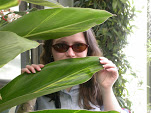 A weed that I neglected to remove all summer has finally come into bloom. It is quite attractive. The flowers are pea shaped (= legume family associations?) and small, less than half an inch. Its not a bad looking critter overall.
A weed that I neglected to remove all summer has finally come into bloom. It is quite attractive. The flowers are pea shaped (= legume family associations?) and small, less than half an inch. Its not a bad looking critter overall. Do any of you know what it is?
Do any of you know what it is?UPDATE: With fluffnflowers comment plus a few from the Orchid Guide Digest I now believe the plant to be either Lespedeza cuneata or bicolor, both of which look very similar to my plant, are found in the whole of the Eastern half of the US, and, unfortunately, are listed as invasive weeds by one or more states. Hm.. I don't suppose anyone would want seed from my pretty little friend then.

2 comments:
Google lespedeza and see what you think. :)
Hi Julia
I think it is Lespedeza juncea, which is not uncommon in Australia also. See ZipCodeZoo (http://zipcodezoo.com/Plants/L/Lespedeza%5Fjuncea/) or Google images for pictures of the species.
Cheers, Greg Steenbeeke
Post a Comment